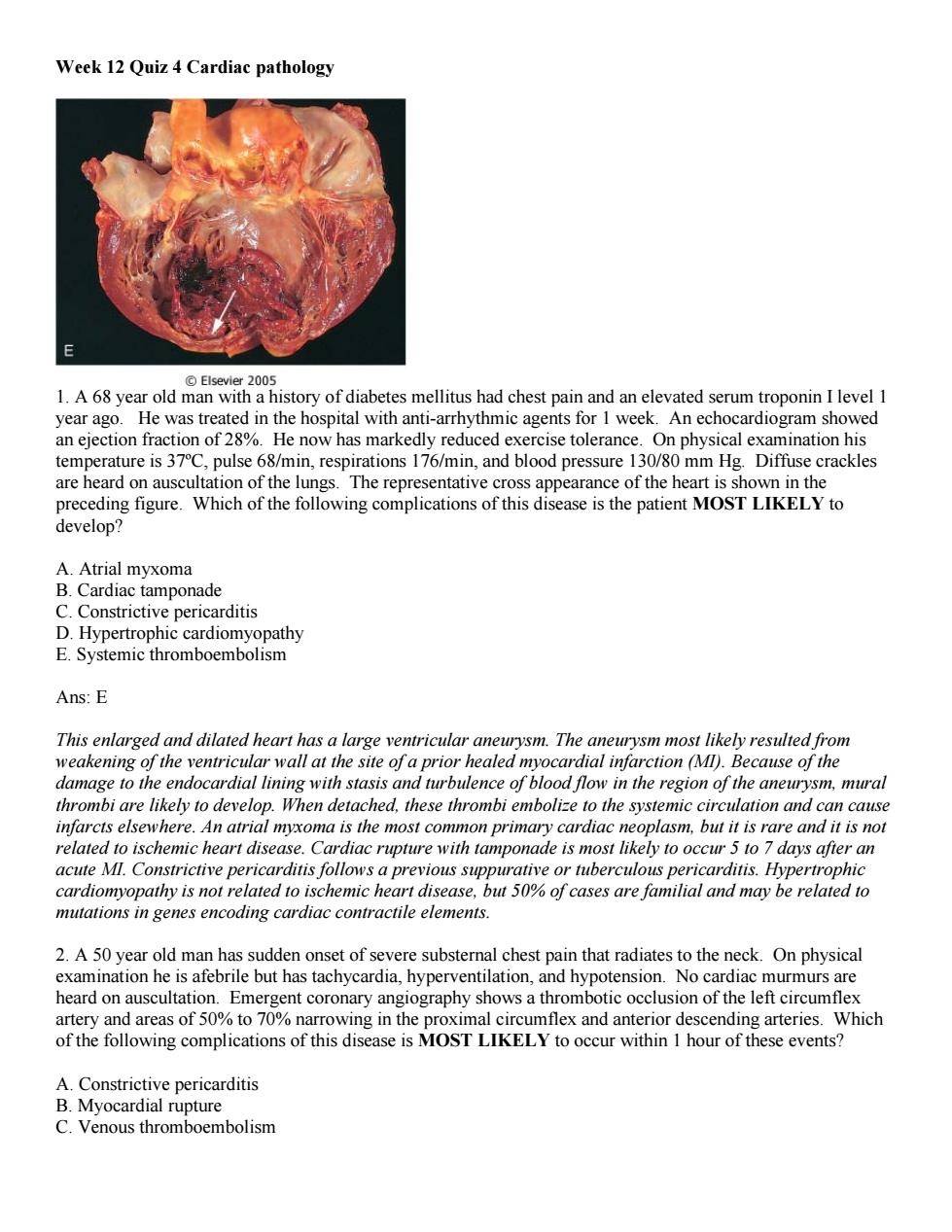正在加载图片...

Week 12 Quiz 4 Cardiac pathology Elsevier 2005 1.A 68 year old man with a history of diabetes mellitus had chest pain and an elevated serum troponin I level year ago.He was treated in the hospital with anti-arrhythmic agents for 1 week.An echocardiogram showed an ejection fraction of 28%.He now has markedly reduced exercise tolerance.On physical examination his temperature is 37C,pulse 68/min,respirations 176/min,and blood pressure 130/80 mm Hg.Diffuse crackles are heard on auscultation of the lungs.The representative cross appearance of the heart is shown in the preceding figure.Which of the following complications of this disease is the patient MOST LIKELY to develop? A Atrial myxoma B.Cardiac tamponade C Constricti ericarditis D.Hypertrophi E.System thromboe Ans:E This enlarged and dilated heart has a large venricular anewrysm.The aneurysm most likely resulted from lar wall at the site ofa prior healed myocardial infarction (MI).Because of the damage to the endocardial linint stasis and urbulence of ld o in the region of the aneuysm.mral thrombi are likely to develop.When detached.these thrombi embolize to the systemic circulation and can cause infarcts elsewhere.An atrial myxoma is the most common primary cardiac neoplasm,but it is rare and it is not related to ischemic heart disease.Cardiac rupture with tamponade is most likely to occur 5 to 7 days after an acute MI.Constrictive pericarditis follows a previous suppurative or tuberculous pericarditis.Hypertrophic cardiomyopathy is not related to ischemic heart disease,but 50%of cases are familial and may be related to mutations in genes encoding cardiac contractile elements. 2.A 50 year old man has sudden onset of severe substernal chest pain that radiates to the neck.On physical examination he is afebrile but has tachycardia.hyperventilation,and hyp otension no cardiac murmurs are heard on auscultation.Emergent coronary an raphy shows a thrombotic occ lusion of the left circumflex artery and areas of 50%to 70%na wing in the imal circumflex and anterior descending arteries Which A.Constricti Week 12 Quiz 4 Cardiac pathology 1. A 68 year old man with a history of diabetes mellitus had chest pain and an elevated serum troponin I level 1 year ago. He was treated in the hospital with anti-arrhythmic agents for 1 week. An echocardiogram showed an ejection fraction of 28%. He now has markedly reduced exercise tolerance. On physical examination his temperature is 37ºC, pulse 68/min, respirations 176/min, and blood pressure 130/80 mm Hg. Diffuse crackles are heard on auscultation of the lungs. The representative cross appearance of the heart is shown in the preceding figure. Which of the following complications of this disease is the patient MOST LIKELY to develop? A. Atrial myxoma B. Cardiac tamponade C. Constrictive pericarditis D. Hypertrophic cardiomyopathy E. Systemic thromboembolism Ans: E This enlarged and dilated heart has a large ventricular aneurysm. The aneurysm most likely resulted from weakening of the ventricular wall at the site of a prior healed myocardial infarction (MI). Because of the damage to the endocardial lining with stasis and turbulence of blood flow in the region of the aneurysm, mural thrombi are likely to develop. When detached, these thrombi embolize to the systemic circulation and can cause infarcts elsewhere. An atrial myxoma is the most common primary cardiac neoplasm, but it is rare and it is not related to ischemic heart disease. Cardiac rupture with tamponade is most likely to occur 5 to 7 days after an acute MI. Constrictive pericarditis follows a previous suppurative or tuberculous pericarditis. Hypertrophic cardiomyopathy is not related to ischemic heart disease, but 50% of cases are familial and may be related to mutations in genes encoding cardiac contractile elements. 2. A 50 year old man has sudden onset of severe substernal chest pain that radiates to the neck. On physical examination he is afebrile but has tachycardia, hyperventilation, and hypotension. No cardiac murmurs are heard on auscultation. Emergent coronary angiography shows a thrombotic occlusion of the left circumflex artery and areas of 50% to 70% narrowing in the proximal circumflex and anterior descending arteries. Which of the following complications of this disease is MOST LIKELY to occur within 1 hour of these events? A. Constrictive pericarditis B. Myocardial rupture C. Venous thromboembolism